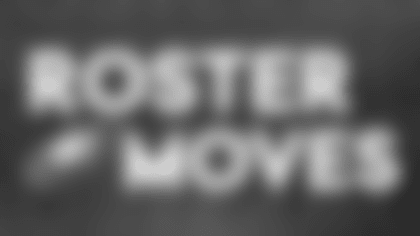I took a look back at the performance of the Eagles' offense Thursday night against Green Bay in my Friday night column, and I'll do the same in the coming days for the defense. However, there's another topic I should hit on first.
The Eagles traded wide receiver Jordan Matthews and a future third-round pick to the Buffalo Bills in exchange for cornerback Ronald Darby, a 23-year-old former second-round selection with outstanding top-end speed and a reputation around the league as one of the up-and-coming corners in the NFL. What does Darby bring to the table and how can he help this Eagles defense in 2017? I went back to my notes on him coming out of Florida State in 2015 and went through a boatload of his tape from his NFL career to help tell the story.
With the Seminoles, Darby was an immediate impact player on a team destined for glory. After being named the ACC Defensive Rookie of the Year in 2012 as a true freshman (on a unit that led the conference in points and passing yards allowed), Darby started nine games for the BCS National Champions in 2013. He was a third-team All-ACC pick as a junior in 2014 when, according to NFL.com, he allowed fewer than 42 percent of the passes thrown in his direction to be caught.
At Florida State, Darby played a ton of press man coverage, and that's where he looked at his best. They played some Cover 3 and some quarters, but he looked like a pure man-to-man corner in college. Whether he was at the line of scrimmage or backed up in off coverage (which he is also capable of doing at a high level), his athleticism allowed him to consistently compete at the catch point in man coverage. He's a top-level athlete at the cornerback position, and it starts with his recovery speed.
At the 2015 Combine, Darby ran a 4.32 40-yard dash. Exactly three cornerbacks picked in the last 10 (!) seasons have bested that time, and all of them were Day 3 picks. This, to me, says that none of them were anywhere near the kind of football player that Darby, a top-50 selection that April, has the ability to be. When I studied him out of FSU, I wrote that Darby was "extremely light on his feet and showed great deep speed downfield with the ability to carry vertical receivers with ease."
At the cornerback position, speed is a great starting point because it gives you the ability to stay "in-phase" at all levels of the field. When I say "in-phase," I'm referring to a defender's ability to stay shoulder to shoulder with a receiver downfield, close enough where he can grab the opponent's wallet out of his hip pocket. From this in-phase position, a cornerback can properly and effectively keep his eyes on the quarterback and, more importantly, the football, allowing him to go up and make a play in the air. Here are two examples of Darby doing just that.
Shot 1 - 2 picture perfect examples of Darby's ability to stay 'in-phase', keeping him in position to play the ball. All starts w/ his SPEED pic.twitter.com/6shK0QhqW8 — Fran Duffy (@fduffy3) August 12, 2017
When you have the kind of speed that Darby has, it makes it much easier for you to stay in-phase, because you can stay hip to hip with a receiver much more effectively and comfortably. Remember, a corner is at an immediate disadvantage before the snap of the ball because more often than not he has to turn and run with a receiver, who merely has to run straight ahead. Darby's speed gives him a really good starting point to stay in the right position to make the play.
In the NFL, however, things don't always go as planned when you play on the outside at this position. You're going to get beat a handful of times (or more) in any game. Having great speed gives you the ability to recover, meaning that when you're "out of phase" (trying to catch up to the receiver downfield), you can catch up and get back into phase at a much quicker pace.
Shot 2 - Speed not only lets you stay in-phase from the snap but it also gives you the chance to recover. This is outstanding makeup speed pic.twitter.com/isXtQdBd14 — Fran Duffy (@fduffy3) August 12, 2017
This is exactly what I'm talking about. There appears to be some pre-snap confusion, and the secondary is not set before Colts quarterback Andrew Luck gets the ball. Darby's man runs right by him early in the down. Luck thinks he's got an easy touchdown, but this is where the recovery speed comes into play. Darby catches up to the receiver - one of the most explosive weapons in the league in T.Y. Hilton - gets his eyes back to the ball and is able to finish in the air for the interception. Darby doesn't have the greatest hands in the league, as his two career interceptions would attest. Was this play picture-perfect from snap to whistle? No, but Darby's raw speed can help make up for a lot of things.
That speed and explosiveness don't just show up on vertical routes. I mentioned earlier that Darby did play a good amount of off coverage with the Seminoles, and he's done it in Buffalo as well. In my notes, I wrote how his feet "were very clean in his pedal, showing the ability to click and close with ease on throws in front of him."
What does "click and close" mean? Imagine a corner in off coverage drop in his pedal. The receiver in front of him breaks off his route, and the corner sticks his foot in the ground and immediately breaks forward on the throw. Some call that "clicking and closing," others may say "plant and drive." No matter what you call it, Darby's got the ability to do it at a high level.
Shot 3 - Watch Darby 'click & close' on this slant route from OBJ. This is also where his ease of movement and explosiveness come into play pic.twitter.com/7n6u8Af2Uu — Fran Duffy (@fduffy3) August 12, 2017
This is a shot from 2015 against Odell Beckham Jr., who runs a quick slant right in front of Darby. From an off coverage position, Darby pedals in reverse, and right when he sees Beckham break inside you see him plant his inside foot, open up at a 45-degree angle, and explode to the catch point. The ball is thrown to the receiver's back shoulder, and Darby shoots his hands through Beckham's to get it on the ground. This was a third-down play that resulted in a punt for the Giants. We haven't been able to see any corners this summer for the Eagles with those kinds of explosive traits, which is why the addition of Darby complements the skill sets of the other corners on the depth chart so well.
As Eagles fans are aware of, being the smart football fans that they are, it takes more than just athleticism, quickness, and change of direction to be a good man coverage player, regardless of whether you play cornerback, safety, or linebacker. A large part of that success comes from instincts, route recognition, and discipline in coverage. There are times, both in college and in the NFL, where Darby was undercut by a receiver because he was a bit too far over the top, or where he was a bit late to break off with the receiver at the top of his stem on, say, a comeback route. He gets his hips flipped too easily and turned around in coverage at times. Does he have the athleticism to lock down the most talented receivers on a consistent snap-to-snap basis?
Absolutely.
Last year, I thought there were a few contributing factors to what many analysts have referred to as a "down year." Some of the receptions he gave up came in situations like I stated above, some came on great routes on double moves by receivers, and others were plays where he was just beaten at the catch point.
As he said in his introductory press conference, he believes that he needs to "finish" better, and when he said that I absolutely thought back to some of those plays. There are plenty of examples of where that dynamic athleticism shows up at the top of routes and he breaks on throws EXACTLY how you want at the position. When it happens, it's a pretty sight to see.
Shot 4 - Darby's quickness and COD skills are also apparent at the top of route breaks. Watch him here against Kenny Stills / Nuk Hopkins pic.twitter.com/v4cm2t4hf0 — Fran Duffy (@fduffy3) August 12, 2017
In the first shot above, Darby is matched up on speedster Kenny Stills at the top of the screen. This is actually a great route by Stills, who sells the vertical route HARD, even looking back at the quarterback for a split second to try and pretend he's looking for the ball. Darby doesn't bite, and you see him sink his hips and drive back to the sideline step for step with Stills to force the incomplete pass. Darby faces a similar route from DeAndre Hopkins on the next shot, and again stays right in the receiver's hip pocket to break up the throw. Darby has had some issues with these kinds of routes in the past, but it's not for lack of ability. He's got the skill set to cover any receiver in this league one-on-one.
Shot 5 - There are times where Darby can get turned around in coverage, but watch how well he recovers here for the PBU. Top-end athleticism pic.twitter.com/uUDAXnBIHW — Fran Duffy (@fduffy3) August 12, 2017
On this play against Jacksonville, Darby faces another strong route, this time from wide receiver Allen Hurns, who sells the vertical route by feigning an outside release before undercutting Darby on a dig route. Darby shifts his wheels, gets back in position, and is able to take advantage of a bad throw to force a pass breakup. The athleticism helps in a big way here and can help mask any false steps in the secondary. When you face good receivers in this league, it's bound to happen.
One thing I noticed last year was that receivers seemed to throw a lot of double moves at Darby and, as to be expected with those kinds of routes, they had some success. Whether they were stutter-and-go routes, post-corner routes or fade stops, I saw a good amount of catches on concepts like that to try and get him leaning one direction before breaking back the opposite way. That being said, he got more than his share of pass breakups on those kinds of routes, and this one was the most impressive.
Shot 6 - You're not supposed to break up passes against routes that look like this. Unbelievably athletic play by Darby here. #Eagles pic.twitter.com/87YM5dMP3h — Fran Duffy (@fduffy3) August 12, 2017
This is a shot against Julian Edelman, one of the craftiest route runners in the league, and the Patriots last year. Edelman runs a route that I'd venture to guess over 98 percent of the corners in the NFL couldn't break up. Edelman runs a double move out-and-up route before breaking the route off back to the sideline. It was, in essence, a triple move. I've seen these routes run in one-on-one drills before in practice where the defender screams at the receiver, "You'll never run that in the game!" Well, Edelman did, and thanks to Darby's fluid hips, easy change of direction, and impressive burst to close on the throw, he breaks up this pass on third-and-6 to force fourth down.
Going back to look at my notes from his college days, there were was one area that I may have been most intrigued to see before turning on the tape with Buffalo.
I was pleased with what I found.
In college, Darby played as the "field corner," meaning he played to the wide side of the field on every play (remember the hashmarks are farther apart in college), but I thought he had the skill set to play both inside and outside in the NFL if given the opportunity. Well, in Buffalo he was.
Shot 7 - Darby slid into the slot at times with Buffalo, giving him an extra layer of versatility when transitioning to the #Eagles defense pic.twitter.com/lUF18AeIkA — Fran Duffy (@fduffy3) August 12, 2017
There are two examples of Darby lined up in the slot, once against Danny Amendola and another against Brandon Marshall. Why is that important? Well, it certainly gives him the ability to "shadow" an opposing receiver. If the Eagles choose to match him up against a player like Beckham or Dez Bryant or Julio Jones, Darby could (in theory) follow him all over the field. It also gives the team flexibility in the future with this group of young corners. With Jalen Mills, Rasul Douglas, and, last but not least, Sidney Jones already in the pipeline, there are several combinations the staff could use when deploying their corners in subpackages.
I was concerned with Darby's ability against the run coming out of Florida State because I didn't always see a committed tackler in college. This is an area where I thought he looked much improved since arriving in the NFL, and I think his experience working with a tough-minded coach like Rex Ryan certainly helped in his development in that area of his game.
Shot 8 - Last look at Darby, who impressed me as a tackler from his NFL tape. Didn't see that at FSU; he's much improved there now #Eagles pic.twitter.com/GNnKysBlEp — Fran Duffy (@fduffy3) August 12, 2017
Darby is an impact tackler, meaning he uses his speed and burst to explode into ball carriers. I saw a lot more willingness from him as a tackler, whether it was on passes to the flat or in the perimeter run game, than I had seen from him at Florida State.
Fran Duffy is the producer of "Eagles Game Plan" which can be seen on Saturdays during the season. Be sure to also check out the "Eagle Eye In The Sky" podcast on the Philadelphia Eagles podcast channel on iTunes. Prior to joining the Eagles in 2011, Duffy was the head video coordinator for the Temple University Football team under former head coach Al Golden. In that role, he spent thousands of hours shooting, logging and assisting with the breakdown of the All-22 film from the team's games, practices and opponents.















